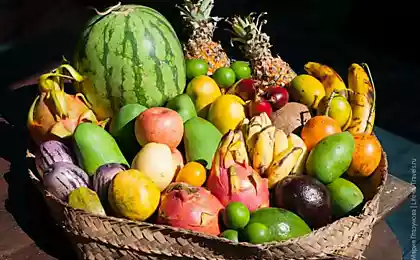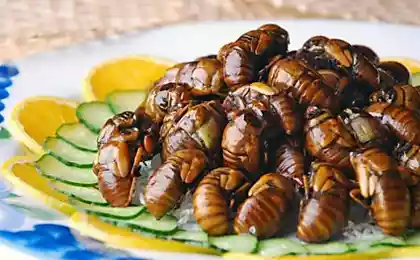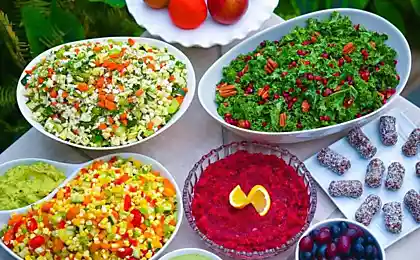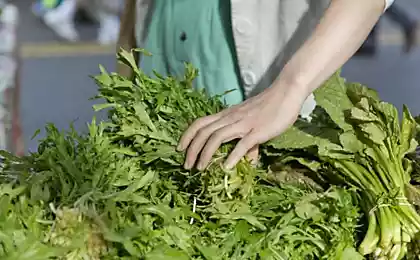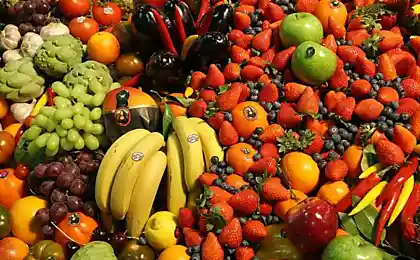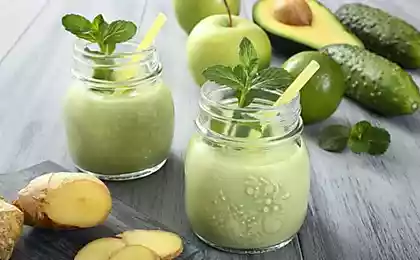1236
Exotic fruits and what they eat
Today, the shelves just bursting with an abundance of all sorts of strange fruit. As befits exotic, their prices bite. On average, a kilogram will cost 80-90 UAH. And to some "wonder" and rolled over for 100 USD. Perhaps that is why many exotic fruits stale on the shelves, and they have, to put it mildly, unpleasant. So you do not spend money on items the second freshness, we learned how should look the most popular "exotics" ideally. Also try them on the tooth - to understand what the fruits are. Outset: that impressions were as objective as possible, sample filmed several people.
via vasily-sergeev, further 15 posts, 15 posts further
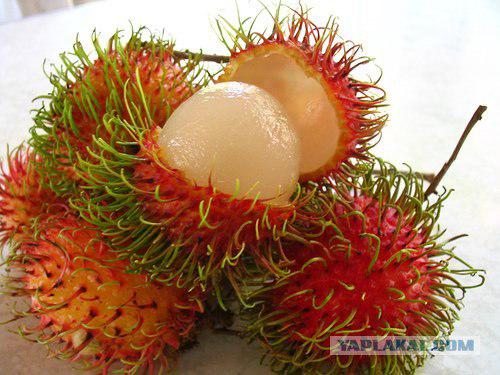
Lychee
Our impressions. The first association - jam from petals of roses, a sweet and aromatic. In taste sensations and appearance litchi it appeared similar to dense jelly. It leaves a very pleasant aftertaste.
Ripe fruit. Round, with a solid red skin covered with spiky "warts." Pulp - glassy-white or reddish, juicy, with a sweet and sour taste.
Addicting. It can be eaten raw, boiled with sugar, canned goods, used in fruit salads.
Usefulness. Vitamins C, B1 and B2, carbohydrates, iron, phosphorus and nicotinic acid. It is used as a tonic, useful for regulating digestion, helps with anemia.
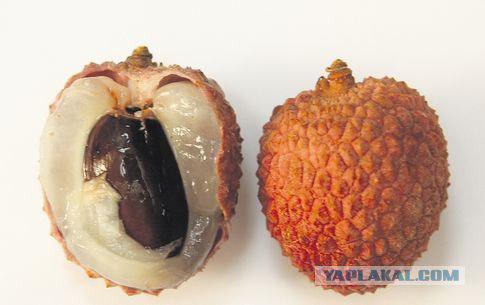
Rambutan
Our impressions. By mouthfeel like a squid, same skolzkovaty. Still it seemed like a sweet jelly, but not fruit, but simply sugar. While some fancied slight tinge of persimmon. Also, all noted the extraordinary richness and what looks like a lychee rambutan, but not as flavorful.
Ripe fruit. Round fruits red or reddish-black, thick rind is covered with soft spines thin, hair-like. Pulp glassy-white, sometimes reddish, very juicy with a pleasant sweet-sour flavor and dense texture.
Addicting. Rambutan rind can be easily removed, after which it can be eaten raw. The pulp can be cooked with sugar, jelly and marmalade making. The seeds are poisonous in its raw form.
Usefulness. The fruit is rich in vitamin C, calcium and phosphorus, perfectly cleanses the body.
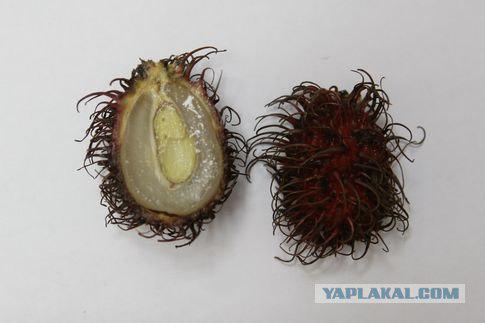
Passionfruit
(Passiflora)
Our impressions. Very strong flavor, similar to the smell of lemon. At the same time it proved to be similar to the number of different fruits: currants, gooseberries underripe, buckthorn. Very sour taste, I want to spit it out immediately, seeds unpleasant taste and it is difficult to separate from the pulp.
Ripe fruit. Rounded berries with thick dense shiny skin, color of purple-brown to blackish brown. Inside the fruit - a cavity surrounded by cotton-like, dry white inedible "fabric" on which there are links from the "buds", which, in turn, are attached to the vitreous seeds orange flesh. The taste - fruity sour.
Addicting. Passion fruit eaten with a spoon out of the skin, can be placed with the seed. Also prepared juice, which is diluted and sweetened, and then it is added to a mixture of juice, yogurt, ice cream. From the pulp making jelly and syrup.
Usefulness. It contains fiber, calcium, phosphorus, iron, B vitamins, A, C, sodium, serotonin. It has laxative properties and improves bowel. It promotes the excretion of uric acid and a febrifuge.
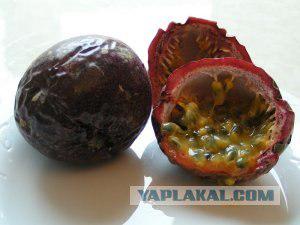
Kiva (African gherkin)
Our impressions. Moderately sweet taste, a bit like a mixture of kiwi, banana and cucumber. Some even seemed tasteless. Inside is really similar to a cucumber with large seeds, it is very slippery pulp, which is not very convenient to eat. But it looks very impressive, so may be suitable for decorating different salads.
Ripe fruit. Fruit up to 15 cm long, bright orange-yellow color, covered with conical spines. Most Nods occupied flat white seeds, which surrounds the glass-bright green, very juicy and sweet flesh.
Addicting. You can eat raw, scooping spoon, add into popsicles or salad.
Usefulness. It contains large amounts of vitamin C.
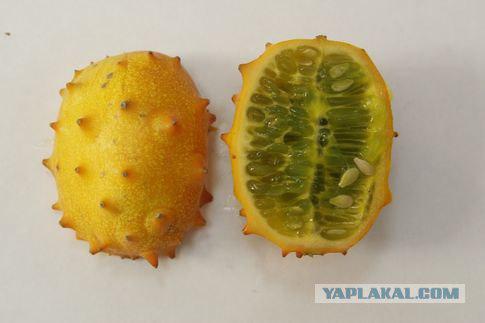
Salak (Salakka)
Our impressions. Awfully hard crust, like a snake's scales, which is difficult to cut. Very strong smell of valerian, and the majority of the taste was similar to the cotton wool soaked in valerian or Corvalol, and looks like wet wool pulp. Discomfort is really "snake fruit", as it is called.
Ripe fruit. Egg-shaped or pear-shaped fruit with a shell consisting of brown scales laid like tiles, and form a dense shell, like snakeskin. Under the skin is thick yellowish-white flesh having a sweet-sour taste similar to pineapple.
Addicting. As a rule, the fruit is eaten raw, but also it can be used in cooked and candied form. Immature fruits are sour and astringent taste, marinate them like pickles.
Usefulness. The pulp contains tannin.
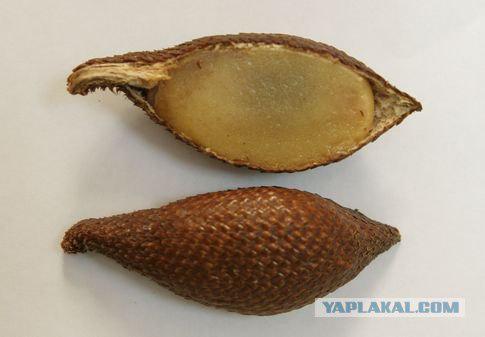
Mangosteen (mangosteen) (Remember the Guest from the Future)
Our impressions. It turned out to be a dark, very dense hard skin, which was the most difficult to cut. Inside looked very unsightly, some brown-brown mass, similar to rot. It tastes slightly salty-sour, on the fruit does not look like a very nasty experience. Judging by the description, it really rotten.
Ripe fruit. Round fruit with a rough tough leathery skin, in the case of ripe fruit - purple-brown. Be sure there are 4 thick, convex sepals. Under cover 8 are light brown seeds, each of which is surrounded by a thick, soft, juicy white shell with a light sweet-sour taste and pleasant aroma. Berries are stored for a short time after removal they quickly moldy inside.
Addicting. Mangosteen is eaten raw, the flesh is possible to preserve with sugar, makes her jelly or jam.
Usefulness. Rich in calcium, phosphorus and vitamins B and C. It is used for diarrhea.
Regarding the mangosteen - notes aeroplan, - it is a snow-white fruit filling, taste like fat seal. A zelenoglazay prompts should look like mangosteen. By the way, very tasty.
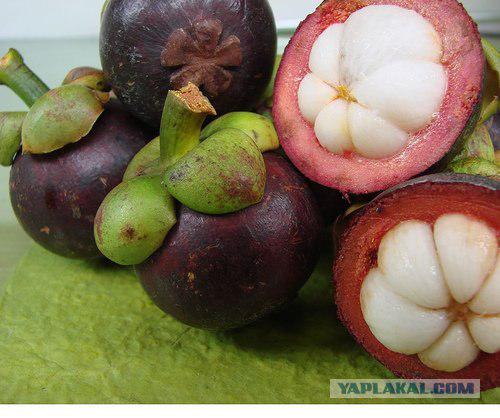
Pitahaya (Pitaya, strawberry pear, "dragon fruit»)
Our impressions. The most beautiful fruit, something like a pine cone, bright pink thin shell hides a white pulp with many small stones. Those bones he looks like a kiwi, and the taste, too, but much less sweet. In general, the taste is very weak tone, some have called the association with raw potatoes, while others experienced a grassy flavor. Enough juicy, so it is with pleasure eaten until the end.
Ripe fruit. Fleshy berries large round or oval in shape, covered with bristling scales. The color of ripe fruit - purple-red, rarely yellow. The rind protects a white juicy pulp with many small black seeds, similar to bone kiwi. It has a pleasant sweet taste.
Addicting. Usually use the pulp, taking a spoon straight from the peel. Also, it can be converted into a puree, adding water, sugar and ice - and get a refreshing drink. Juice and pulp is added to yogurt and ice cream.
Usefulness. It contains a lot of calcium, iron, vitamins B1, B2, C Fruit useful diabetes or other endocrine diseases.

Starfruit (carambola)
Our impressions. As Pitahaya, very beautiful, but amazingly tasteless. The taste has appeared similar to aloe (agave), but not bitter, and still the green plum. Very juicy, so it has a nice heat. The smell - as if rubbed the leaves of cucumber, or agave. Well suited to decorate salads.
Ripe fruit. Fleshy berries in mature state from greenish-yellow to orange-yellow in color, similar to the five-pointed star in the section. Their flesh is juicy and dense, has a sweet and sour refreshing taste.
Addicting. The berries are eaten raw with sugar or in fruit salads. It is also possible to crystallize the fruit slices or canned. Juice Cannon drunk as a refreshing drink. "Star" you can decorate salads.
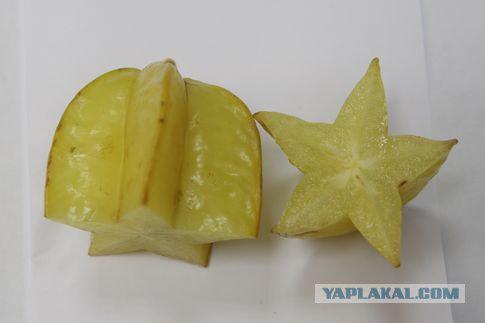
GRENADILLA (Sweet Granadilla)
Our impressions. Very thick peel, which bends when you try to cut. Pulp caused association with jellyfish. The taste someone this "exotic" recalled gooseberries. But most converged in opinion that grenadilla leaves the aftertaste of black currant.
Ripe fruit. It is a relative of passion fruit, which has egg-shaped, with a thin hard and brittle skin, which is in a phase of maturity becomes yellowish-orange with green and brownish patterns. Inside - a white tasteless dry pulp, as well as bridges, like passion fruit, tree seeds and buds with a translucent shell. It has a faint aroma and sweet taste with slight acidity.
Addicting. Granadilla usually eaten with a spoon straight from the peel, and from it we can make juice.
Usefulness. It contains vitamins A, C and K, phosphorus, iron and calcium.
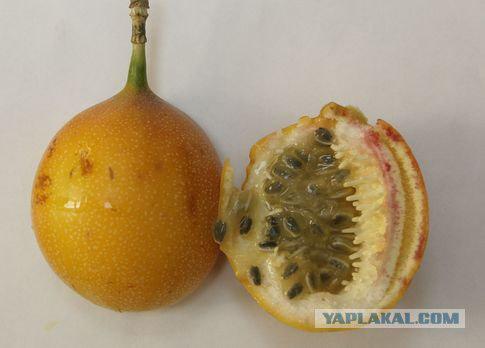
Feijoa
Our impressions. Its flavor and feijoa - "brother" of strawberries. Medium soft, a bit like the kiwi, it is not particularly juicy. Taste pleasant.
Ripe fruit. Large, slightly elongated berries, covered with a bluish waxy coating. The interior of the fruit resembles gooseberries and kiwi, and the taste and aroma - pineapple and strawberries.
Addicting. Fruits eat mostly fresh, as well as prepare them juices, jams, compotes, jams.
Usefulness. Vitamins C and E, sugars, organic acids, pectins, inorganic salts, a rather high amount of iodine. Feijoa helpful for preventing thyroid disease and atherosclerosis.
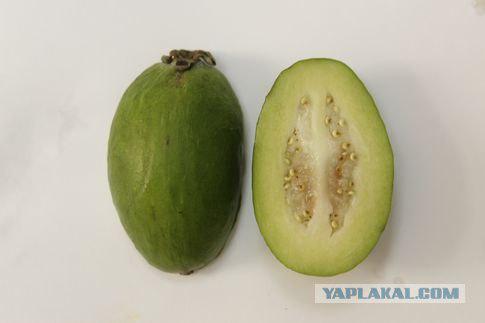
Sapodilla
Our impressions. We caught clearly unripe fruit: he was the taste is very pungent, astringent, like nedospevshaya persimmon. To all the same sapodilla it was dry enough.
Ripe fruit. There are two varieties of this fruit first - an elongated oval shape, with brown skin and slightly grainy honey-sweet pulp reddish-brown color. The second - a round, also with brown skin and a reddish-brown sweet and juicy flesh. Ripe fruit is always slightly soft to the touch, taste reminiscent of pear soaked in syrup of brown sugar. Eat it should be only when fully ripe, because before that he would not be very pleasant to the taste because it contained tannin and latex milk. Immature fruit is hard and astringent taste (it was and got us to the test).
Addicting. Sapodilla can be eaten raw, including with lime juice, add to fruit salads, as a filling in flour, making of her puree or jam.
Usefulness. Sapodilla rich in vitamins A and C, as well as calcium.
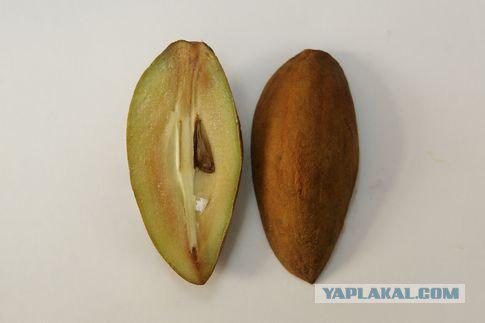
Kumquat (GOLDEN ORANGE)
Our impressions. Outwardly it looks like a tiny orange taste - sour lime with a weak aroma of mandarin. The skin also looks like a tangerine, thin and tasty. We have assumed that fruit will be good in cocktails, as well as a snack like a lemon tequila.
Ripe fruit. Fruits are similar to other citrus fruits, but much smaller, length approximately phalanx oval orange. Have a soft skin and sweet juicy flesh is sour.
Addicting. Kumquat can be eaten raw with the skin, added to salads as a decoration, crystallize and preserve, cook marmalade or jelly.
Usefulness. Contains vitamins C and E. In folk medicine, the East is used to treat fungal infections, respiratory illnesses, and even to relieve hangover.
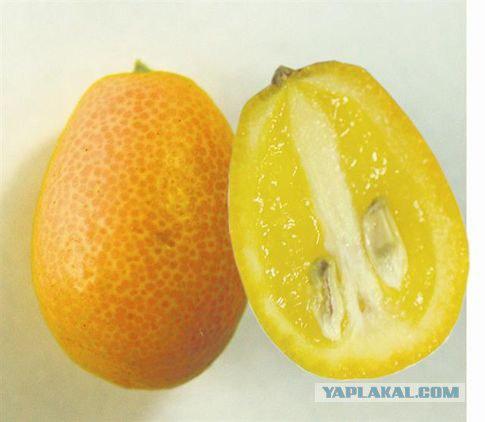
Guava (guava)
Our impressions. We got very green guava, proved to be quite sour, but not very rich taste with a clear spicy flavor. However, it left a pleasant aftertaste, something like a quince - it was in solidarity with all. In addition, the white flesh of the fruit has been tough enough.
Ripe fruit. Oval, round or apple-berry, green or yellow-green, often with pink spots. Its flesh must be very juicy, grainy, off-white, yellow, yellow-green or pink, and in the center - a bright red color. In the mature form it has a pleasant sweet-sour taste, similar to a pear or strawberry, but unripe fruits are acidic and astringent.
Addicting. The fruits of guava eaten fresh, cooked or canned along with the seeds. Also because it can make jellies, jams and juice.
Usefulness. It contains a lot of vitamins A, B and especially C, up to 10 times more than other citrus.
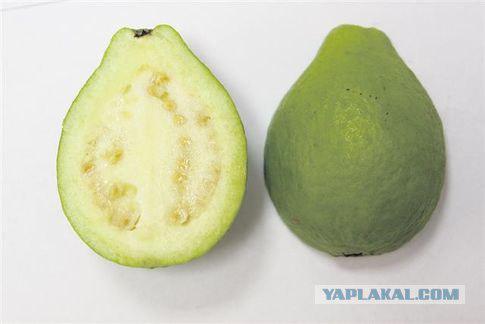
Pepin (Melon Pear)
Our impressions. In appearance, immediately conjures up a melon on the palate, too, like a melon, but immature, ie special taste it does not have the flavor is very weak. Moreover, all noted that the fruit is very juicy and pleasantly refreshing. It was one of the few fruits that are eaten until the end.
Ripe fruit. Enough large berries (size 10-15 x 8-10 cm), egg-shaped, round or oval. The skin is yellow with red-brown spots or stripes. Light yellow, soft, very juicy flesh tastes like melon and pear.
Addicting. Like many other "exotic", primarily used fresh as a dessert or it is added to fruit salad. Also, from the fruit of the pepino make jam, jam, compotes, canned, dried and frozen. Peel some varieties should be removed, because it has an unpleasant taste. Seeds are edible, but if desired, can be very easy to remove.
Usefulness. Pepino is the same source of vitamin C as citrus and many (about 35 mg per 100 g). It also contains a sufficiently large amount of vitamin A, B1 and PP. It consists of 92% water and only about 7% carbohydrate.
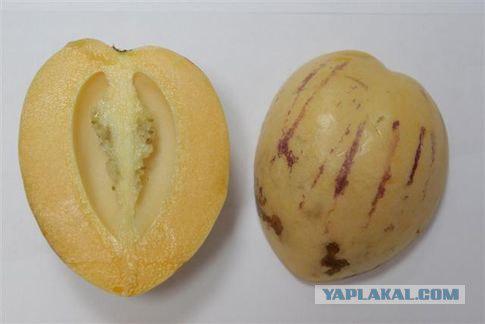
Cactus fruit (INZHIROVY CACTUS, INDIAN FIGS) penultimate post
Our impressions. Very sweet fruit, perhaps, the sweetest of all, we tried. Also, very juicy, juice literally dripped on his fingers. Most called association or with boiled pumpkin or apple oxides. Some noted a light scent of vanilla.
Ripe fruit. The color of the fruit inside and outside chartreuse or varies from orange to burgundy, thin skin is covered with "spikes". The juicy pulp is usually transparent greenish or reddish in color surrounded by a thin layer of pulp. The fruit is sweet, reminiscent of a cross between a ripe melon and kiwi.
Addicting. Cactus can be eaten raw, taking the spoon, or used for jams and candied fruits.
Usefulness. Fruit contains oxalic acid crystals.
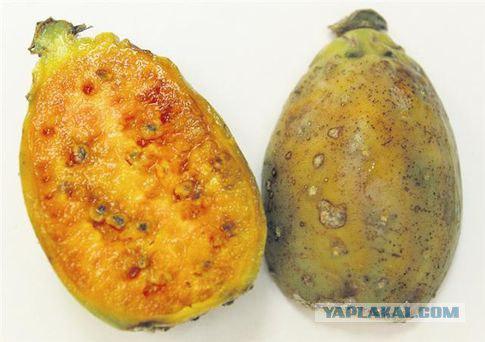
Tamarillo (tamarillo, tomato tree) last
Our impressions. It looked very attractive due to the dark cherry color. Turned out to be a very unpalatable, astringent, it is difficult and unpleasant to swallow salty aftertaste left. From rotten fruit smelled vegetables appeared wide range of options: from humus melon flavor to the same humus grapes.
Ripe fruit. Pointy-ovoid berries, orange, tomato-colored or purple-red shiny skin, often with dark stripes. The flesh should be yellowish-red color with a sour taste and texture of plums, the taste slightly sour.
Addicting. Ripe berries are eaten with a spoon straight from the peel, pre sprinkle with sugar, slices of tamarillo is used in fruit salads and stewed fruit eaten as a vegetable.
Usefulness. It contains large amounts of vitamins A, B6, C and E, iron, potassium, sodium and no cholesterol. You can have those who suffer from frequent migraines.
EXPERT OPINION. Advises Alexander Martynchuk, mednauk PhD, dietitian, a gastroenterologist Medical Center "Alkat»:
The exotic fruit, of course, contains a significant proportion of vitamins, as well as in any other. Dominated by vitamins C, since most of them are citrus fruits. But potentially "exotic" is more allergenic for our residents. This can be explained by the fact that initially our body adapt to the assimilation of "local" products. Plus there are so-called "block" with respect to the absorption of certain nutrients: this means that even the usual fruit should not eat kilograms, be acquired only part of the body needs.
As for the "exotic", the saturation of going even faster - say, if the day to eat 3-4 apples for a certain dose of nutrients, the overseas fruit enough for one or even less. That is to eat them, of course, you can, but do not overdo it. And especially should be careful with the use of exotic fruits young children (especially "diateznikam"), older people: they have reduced the possibility of their assimilation. Do not experiment and pregnant women: the reaction of the baby to "novelty" can be unpredictable.
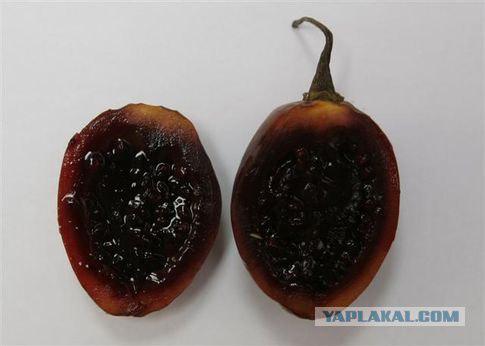
Source:
via vasily-sergeev, further 15 posts, 15 posts further

Lychee
Our impressions. The first association - jam from petals of roses, a sweet and aromatic. In taste sensations and appearance litchi it appeared similar to dense jelly. It leaves a very pleasant aftertaste.
Ripe fruit. Round, with a solid red skin covered with spiky "warts." Pulp - glassy-white or reddish, juicy, with a sweet and sour taste.
Addicting. It can be eaten raw, boiled with sugar, canned goods, used in fruit salads.
Usefulness. Vitamins C, B1 and B2, carbohydrates, iron, phosphorus and nicotinic acid. It is used as a tonic, useful for regulating digestion, helps with anemia.

Rambutan
Our impressions. By mouthfeel like a squid, same skolzkovaty. Still it seemed like a sweet jelly, but not fruit, but simply sugar. While some fancied slight tinge of persimmon. Also, all noted the extraordinary richness and what looks like a lychee rambutan, but not as flavorful.
Ripe fruit. Round fruits red or reddish-black, thick rind is covered with soft spines thin, hair-like. Pulp glassy-white, sometimes reddish, very juicy with a pleasant sweet-sour flavor and dense texture.
Addicting. Rambutan rind can be easily removed, after which it can be eaten raw. The pulp can be cooked with sugar, jelly and marmalade making. The seeds are poisonous in its raw form.
Usefulness. The fruit is rich in vitamin C, calcium and phosphorus, perfectly cleanses the body.

Passionfruit
(Passiflora)
Our impressions. Very strong flavor, similar to the smell of lemon. At the same time it proved to be similar to the number of different fruits: currants, gooseberries underripe, buckthorn. Very sour taste, I want to spit it out immediately, seeds unpleasant taste and it is difficult to separate from the pulp.
Ripe fruit. Rounded berries with thick dense shiny skin, color of purple-brown to blackish brown. Inside the fruit - a cavity surrounded by cotton-like, dry white inedible "fabric" on which there are links from the "buds", which, in turn, are attached to the vitreous seeds orange flesh. The taste - fruity sour.
Addicting. Passion fruit eaten with a spoon out of the skin, can be placed with the seed. Also prepared juice, which is diluted and sweetened, and then it is added to a mixture of juice, yogurt, ice cream. From the pulp making jelly and syrup.
Usefulness. It contains fiber, calcium, phosphorus, iron, B vitamins, A, C, sodium, serotonin. It has laxative properties and improves bowel. It promotes the excretion of uric acid and a febrifuge.

Kiva (African gherkin)
Our impressions. Moderately sweet taste, a bit like a mixture of kiwi, banana and cucumber. Some even seemed tasteless. Inside is really similar to a cucumber with large seeds, it is very slippery pulp, which is not very convenient to eat. But it looks very impressive, so may be suitable for decorating different salads.
Ripe fruit. Fruit up to 15 cm long, bright orange-yellow color, covered with conical spines. Most Nods occupied flat white seeds, which surrounds the glass-bright green, very juicy and sweet flesh.
Addicting. You can eat raw, scooping spoon, add into popsicles or salad.
Usefulness. It contains large amounts of vitamin C.

Salak (Salakka)
Our impressions. Awfully hard crust, like a snake's scales, which is difficult to cut. Very strong smell of valerian, and the majority of the taste was similar to the cotton wool soaked in valerian or Corvalol, and looks like wet wool pulp. Discomfort is really "snake fruit", as it is called.
Ripe fruit. Egg-shaped or pear-shaped fruit with a shell consisting of brown scales laid like tiles, and form a dense shell, like snakeskin. Under the skin is thick yellowish-white flesh having a sweet-sour taste similar to pineapple.
Addicting. As a rule, the fruit is eaten raw, but also it can be used in cooked and candied form. Immature fruits are sour and astringent taste, marinate them like pickles.
Usefulness. The pulp contains tannin.

Mangosteen (mangosteen) (Remember the Guest from the Future)
Our impressions. It turned out to be a dark, very dense hard skin, which was the most difficult to cut. Inside looked very unsightly, some brown-brown mass, similar to rot. It tastes slightly salty-sour, on the fruit does not look like a very nasty experience. Judging by the description, it really rotten.
Ripe fruit. Round fruit with a rough tough leathery skin, in the case of ripe fruit - purple-brown. Be sure there are 4 thick, convex sepals. Under cover 8 are light brown seeds, each of which is surrounded by a thick, soft, juicy white shell with a light sweet-sour taste and pleasant aroma. Berries are stored for a short time after removal they quickly moldy inside.
Addicting. Mangosteen is eaten raw, the flesh is possible to preserve with sugar, makes her jelly or jam.
Usefulness. Rich in calcium, phosphorus and vitamins B and C. It is used for diarrhea.
Regarding the mangosteen - notes aeroplan, - it is a snow-white fruit filling, taste like fat seal. A zelenoglazay prompts should look like mangosteen. By the way, very tasty.

Pitahaya (Pitaya, strawberry pear, "dragon fruit»)
Our impressions. The most beautiful fruit, something like a pine cone, bright pink thin shell hides a white pulp with many small stones. Those bones he looks like a kiwi, and the taste, too, but much less sweet. In general, the taste is very weak tone, some have called the association with raw potatoes, while others experienced a grassy flavor. Enough juicy, so it is with pleasure eaten until the end.
Ripe fruit. Fleshy berries large round or oval in shape, covered with bristling scales. The color of ripe fruit - purple-red, rarely yellow. The rind protects a white juicy pulp with many small black seeds, similar to bone kiwi. It has a pleasant sweet taste.
Addicting. Usually use the pulp, taking a spoon straight from the peel. Also, it can be converted into a puree, adding water, sugar and ice - and get a refreshing drink. Juice and pulp is added to yogurt and ice cream.
Usefulness. It contains a lot of calcium, iron, vitamins B1, B2, C Fruit useful diabetes or other endocrine diseases.

Starfruit (carambola)
Our impressions. As Pitahaya, very beautiful, but amazingly tasteless. The taste has appeared similar to aloe (agave), but not bitter, and still the green plum. Very juicy, so it has a nice heat. The smell - as if rubbed the leaves of cucumber, or agave. Well suited to decorate salads.
Ripe fruit. Fleshy berries in mature state from greenish-yellow to orange-yellow in color, similar to the five-pointed star in the section. Their flesh is juicy and dense, has a sweet and sour refreshing taste.
Addicting. The berries are eaten raw with sugar or in fruit salads. It is also possible to crystallize the fruit slices or canned. Juice Cannon drunk as a refreshing drink. "Star" you can decorate salads.

GRENADILLA (Sweet Granadilla)
Our impressions. Very thick peel, which bends when you try to cut. Pulp caused association with jellyfish. The taste someone this "exotic" recalled gooseberries. But most converged in opinion that grenadilla leaves the aftertaste of black currant.
Ripe fruit. It is a relative of passion fruit, which has egg-shaped, with a thin hard and brittle skin, which is in a phase of maturity becomes yellowish-orange with green and brownish patterns. Inside - a white tasteless dry pulp, as well as bridges, like passion fruit, tree seeds and buds with a translucent shell. It has a faint aroma and sweet taste with slight acidity.
Addicting. Granadilla usually eaten with a spoon straight from the peel, and from it we can make juice.
Usefulness. It contains vitamins A, C and K, phosphorus, iron and calcium.

Feijoa
Our impressions. Its flavor and feijoa - "brother" of strawberries. Medium soft, a bit like the kiwi, it is not particularly juicy. Taste pleasant.
Ripe fruit. Large, slightly elongated berries, covered with a bluish waxy coating. The interior of the fruit resembles gooseberries and kiwi, and the taste and aroma - pineapple and strawberries.
Addicting. Fruits eat mostly fresh, as well as prepare them juices, jams, compotes, jams.
Usefulness. Vitamins C and E, sugars, organic acids, pectins, inorganic salts, a rather high amount of iodine. Feijoa helpful for preventing thyroid disease and atherosclerosis.

Sapodilla
Our impressions. We caught clearly unripe fruit: he was the taste is very pungent, astringent, like nedospevshaya persimmon. To all the same sapodilla it was dry enough.
Ripe fruit. There are two varieties of this fruit first - an elongated oval shape, with brown skin and slightly grainy honey-sweet pulp reddish-brown color. The second - a round, also with brown skin and a reddish-brown sweet and juicy flesh. Ripe fruit is always slightly soft to the touch, taste reminiscent of pear soaked in syrup of brown sugar. Eat it should be only when fully ripe, because before that he would not be very pleasant to the taste because it contained tannin and latex milk. Immature fruit is hard and astringent taste (it was and got us to the test).
Addicting. Sapodilla can be eaten raw, including with lime juice, add to fruit salads, as a filling in flour, making of her puree or jam.
Usefulness. Sapodilla rich in vitamins A and C, as well as calcium.

Kumquat (GOLDEN ORANGE)
Our impressions. Outwardly it looks like a tiny orange taste - sour lime with a weak aroma of mandarin. The skin also looks like a tangerine, thin and tasty. We have assumed that fruit will be good in cocktails, as well as a snack like a lemon tequila.
Ripe fruit. Fruits are similar to other citrus fruits, but much smaller, length approximately phalanx oval orange. Have a soft skin and sweet juicy flesh is sour.
Addicting. Kumquat can be eaten raw with the skin, added to salads as a decoration, crystallize and preserve, cook marmalade or jelly.
Usefulness. Contains vitamins C and E. In folk medicine, the East is used to treat fungal infections, respiratory illnesses, and even to relieve hangover.

Guava (guava)
Our impressions. We got very green guava, proved to be quite sour, but not very rich taste with a clear spicy flavor. However, it left a pleasant aftertaste, something like a quince - it was in solidarity with all. In addition, the white flesh of the fruit has been tough enough.
Ripe fruit. Oval, round or apple-berry, green or yellow-green, often with pink spots. Its flesh must be very juicy, grainy, off-white, yellow, yellow-green or pink, and in the center - a bright red color. In the mature form it has a pleasant sweet-sour taste, similar to a pear or strawberry, but unripe fruits are acidic and astringent.
Addicting. The fruits of guava eaten fresh, cooked or canned along with the seeds. Also because it can make jellies, jams and juice.
Usefulness. It contains a lot of vitamins A, B and especially C, up to 10 times more than other citrus.

Pepin (Melon Pear)
Our impressions. In appearance, immediately conjures up a melon on the palate, too, like a melon, but immature, ie special taste it does not have the flavor is very weak. Moreover, all noted that the fruit is very juicy and pleasantly refreshing. It was one of the few fruits that are eaten until the end.
Ripe fruit. Enough large berries (size 10-15 x 8-10 cm), egg-shaped, round or oval. The skin is yellow with red-brown spots or stripes. Light yellow, soft, very juicy flesh tastes like melon and pear.
Addicting. Like many other "exotic", primarily used fresh as a dessert or it is added to fruit salad. Also, from the fruit of the pepino make jam, jam, compotes, canned, dried and frozen. Peel some varieties should be removed, because it has an unpleasant taste. Seeds are edible, but if desired, can be very easy to remove.
Usefulness. Pepino is the same source of vitamin C as citrus and many (about 35 mg per 100 g). It also contains a sufficiently large amount of vitamin A, B1 and PP. It consists of 92% water and only about 7% carbohydrate.

Cactus fruit (INZHIROVY CACTUS, INDIAN FIGS) penultimate post
Our impressions. Very sweet fruit, perhaps, the sweetest of all, we tried. Also, very juicy, juice literally dripped on his fingers. Most called association or with boiled pumpkin or apple oxides. Some noted a light scent of vanilla.
Ripe fruit. The color of the fruit inside and outside chartreuse or varies from orange to burgundy, thin skin is covered with "spikes". The juicy pulp is usually transparent greenish or reddish in color surrounded by a thin layer of pulp. The fruit is sweet, reminiscent of a cross between a ripe melon and kiwi.
Addicting. Cactus can be eaten raw, taking the spoon, or used for jams and candied fruits.
Usefulness. Fruit contains oxalic acid crystals.

Tamarillo (tamarillo, tomato tree) last
Our impressions. It looked very attractive due to the dark cherry color. Turned out to be a very unpalatable, astringent, it is difficult and unpleasant to swallow salty aftertaste left. From rotten fruit smelled vegetables appeared wide range of options: from humus melon flavor to the same humus grapes.
Ripe fruit. Pointy-ovoid berries, orange, tomato-colored or purple-red shiny skin, often with dark stripes. The flesh should be yellowish-red color with a sour taste and texture of plums, the taste slightly sour.
Addicting. Ripe berries are eaten with a spoon straight from the peel, pre sprinkle with sugar, slices of tamarillo is used in fruit salads and stewed fruit eaten as a vegetable.
Usefulness. It contains large amounts of vitamins A, B6, C and E, iron, potassium, sodium and no cholesterol. You can have those who suffer from frequent migraines.
EXPERT OPINION. Advises Alexander Martynchuk, mednauk PhD, dietitian, a gastroenterologist Medical Center "Alkat»:
The exotic fruit, of course, contains a significant proportion of vitamins, as well as in any other. Dominated by vitamins C, since most of them are citrus fruits. But potentially "exotic" is more allergenic for our residents. This can be explained by the fact that initially our body adapt to the assimilation of "local" products. Plus there are so-called "block" with respect to the absorption of certain nutrients: this means that even the usual fruit should not eat kilograms, be acquired only part of the body needs.
As for the "exotic", the saturation of going even faster - say, if the day to eat 3-4 apples for a certain dose of nutrients, the overseas fruit enough for one or even less. That is to eat them, of course, you can, but do not overdo it. And especially should be careful with the use of exotic fruits young children (especially "diateznikam"), older people: they have reduced the possibility of their assimilation. Do not experiment and pregnant women: the reaction of the baby to "novelty" can be unpredictable.

Source:


